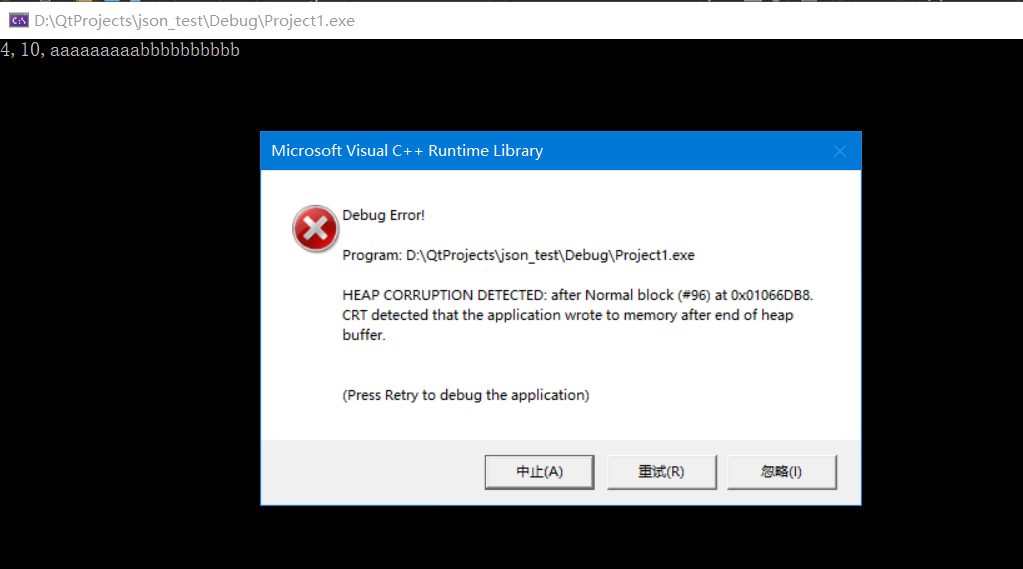简单的写了一下关于C语言和C++中的Struct结构体的定义的疑惑点和C99新增的柔性数组的使用和理解。
一、关于C语言和C++中的Struct结构体的定义 1、C语言 对于C语言,结构体的定义可以是以下的标准定义法:
点击查看代码
1 2 3 4 5 6 7 8 9 10 11 12 13 14 #include <stdio.h> #include <stdlib.h> struct TEST { int a; }; int main (int argc, char const *argv[]) struct TEST test ; test.a = 1 ; printf ("%d\n" , test.a); return 0 ; }
像这样就定义了一个结构体TEST,在声明新结构体变量时,需要使用“struct TEST test”,“struct”必须有,不写会报错,“struct TEST”就相当于是“int”。
直接在结构体里赋初值是不允许的,例如:
点击查看代码
1 2 3 4 5 6 7 8 9 10 11 12 13 #include <stdio.h> #include <stdlib.h> struct TEST { int a = 1 ; }; int main (int argc, char const *argv[]) struct TEST test ; printf ("%d\n" , test.a); return 0 ; }
会产生如下错误:
另外,除了标准定义法,C语言还支持直接在定义结构体的时候声明变量,以及给结构体重命名:
点击查看代码
1 2 3 4 5 6 7 8 9 10 11 12 13 14 15 16 17 18 19 20 21 22 23 24 #include <stdio.h> #include <stdlib.h> struct TEST1 { int a; } test1; typedef struct TEST2 { int a; } TEST2; int main (int argc, char const *argv[]) struct TEST1 test11 ; TEST2 test2; struct TEST2 test22 ; test1.a = 1 ; test2.a = 2 ; test11.a = 11 ; test22.a = 22 ; printf ("%d,%d,%d,%d\n" , test1.a, test2.a, test11.a, test22.a); return 0 ; }
可以看出,TEST1是直接在定义结构体时就声明了一个变量test1,在下面可以直接使用test1访问结构体成员a,另外你仍然可以在后面使用标准方法定义新的TEST1结构体。
而对于TEST2,则是使用“typedef”将“struct TEST2”起了个别名叫“TEST2”,因此后面既可以使用struct TEST2”也可以使用“TEST2”声明TEST2结构体变量。
在定义结构体的时候,你也可以省略TEST1或者TEST2不写,但是这样对于没有起别名的TEST1就只能在定义结构体的时候声明结构体变量,在后面不能定义(因为没有名字,很好理解),相当于是一次性的结构体。但是对于起了别名的TEST2,在后面就只能使用TEST2来声明结构体变量,而不能再使用标准的“struct TEST2”。
点击查看代码
1 2 3 4 5 6 7 8 9 10 11 12 13 14 15 16 17 18 19 20 #include <stdio.h> #include <stdlib.h> struct { int a; } test1; typedef struct { int a; } TEST2; int main (int argc, char const *argv[]) TEST2 test2; test1.a = 1 ; test2.a = 2 ; printf ("%d,%d\n" , test1.a, test2.a); return 0 ; }
2、C++ 对于C++,因为C++是面向对象的程序设计语言,结构体struct就相当于是C++的类class,只是默认继承访问权限不同,class默认的是private,strcut默认的是public。你甚至可以在结构体定义函数,这是在C语言里不允许的,并且C++也允许声明结构体变量时省略“struct”,这个在C语言里也不允许,除非使用typedef起别名。
点击查看代码
1 2 3 4 5 6 7 8 9 10 11 12 13 14 15 16 17 18 19 #include <iostream> using namespace std ;struct TEST { int a = 1 ; void hello () { cout << "hello world" << endl ; }; }; int main (int argc, char const *argv[]) struct TEST test1 ; TEST test2; cout << test1.a << endl ; test2.hello(); return 0 ; }
当然,C++也允许对类或者结构体起别名:
点击查看代码
1 2 3 4 5 6 7 8 9 10 11 12 13 14 15 16 17 18 19 20 21 #include <iostream> using namespace std ;typedef struct TEST { int a = 1 ; void hello () { cout << "hello world" << endl ; }; } T; int main (int argc, char const *argv[]) struct TEST test1 ; TEST test2; T test3; cout << test1.a << endl ; test2.hello(); test3.hello(); return 0 ; }
直接在定义结构体的时候声明变量也可以:
点击查看代码
1 2 3 4 5 6 7 8 9 10 11 12 13 14 15 16 17 18 19 20 #include <iostream> using namespace std ;struct TEST { int a = 1 ; void hello () { cout << "hello world" << endl ; }; } test3; int main (int argc, char const *argv[]) struct TEST test1 ; TEST test2; cout << test1.a << endl ; test2.hello(); test3.hello(); return 0 ; }
二、关于C99新增的柔性数组 在C99中,结构中的最后一个元素允许是未知大小的数组,这就叫做柔性数组成员,但结构中的柔性数组成员前面必须至少一个其他成员。柔性数组成员允许结构中包含一个大小可变的数组。sizeof返回的这种结构大小不包括柔性数组的内存。包含柔性数组成员的结构用malloc函数进行内存的动态分配,并且分配的内存应该大于结构的大小,以适应柔性数组的预期大小。
例如:
点击查看代码
1 2 3 4 5 6 7 8 9 10 11 12 13 14 15 16 #include <stdio.h> #include <stdlib.h> typedef struct TEST { int a; char b[]; } T; int main (int argc, char const *argv[]) T test; T *test_ptr; test.a = 1 ; printf ("%d,%d,%d,%d\n" , test.a, sizeof (T), sizeof (test), sizeof (*test_ptr)); return 0 ; }
我们可以发现,结构体的大小确实等于一个整型的大小4字节,也就是a的大小,b数组是没有占空间的。对于编译器来说,此时长度为0的数组并不占用空间,因为数组名本身不占空间,它只是一个偏移量,数组名这个符号本身代表了一个不可修改的地址常量 ,但对于这个数组的大小,我们可以进行动态分配。当我们对结构体指针test_ptr进行malloc分配内存空间,分配的空间减去sizeof(T)就是柔性数组b的空间,我们就可以对b操作了。其实,b就是柔性数组,或者叫动态数组。这个操作常用于缓冲区或者网络通信中构造不定长数据包。
例如:
点击查看代码
1 2 3 4 5 6 7 8 9 10 11 12 13 14 15 16 17 18 19 #include <stdio.h> #include <stdlib.h> #include <string.h> typedef struct TEST { int a; char b[]; } T; int main (int argc, char const * argv[]) T* test_ptr; test_ptr = (T*)malloc (sizeof (T) + 10 * sizeof (char )); test_ptr->a = 10 ; strcpy (test_ptr->b, "aaaaaaaaa" ); printf ("%d,%d,%s\n" , sizeof (*test_ptr), test_ptr->a, test_ptr->b); free (test_ptr); return 0 ; }
可以发现T的大小依然是4字节,因此b明确来说不算是结构体成员。但是我们却可以使用长度为10的数组b。但为什么我只能复制9个a到数组b呢,其实9个a的字符串长度就是10,因为常量字符串最后一个字符是‘\0’,用于标志字符串而结束,因此实际上b[9]是‘\0’。那如果我们此时强制访问越界会怎么样呢?
点击查看代码
1 2 3 4 5 6 7 8 9 10 11 12 13 14 15 16 17 18 19 #include <stdio.h> #include <stdlib.h> #include <string.h> typedef struct TEST { int a; char b[]; } T; int main (int argc, char const * argv[]) T* test_ptr; test_ptr = (T*)malloc (sizeof (T) + 10 * sizeof (char )); test_ptr->a = 10 ; strcpy (test_ptr->b, "aaaaaaaaabbbbbbbbbb" ); printf ("%d,%d,%s\n" , sizeof (*test_ptr), test_ptr->a, test_ptr->b); free (test_ptr); return 0 ; }
可以发现产生了异常,但是后面的b却被成功打印了出来。经过调试,发现是free语句产生的异常,如果我们把free语句注释掉,就能正常跑了,但是显然不应该这么做,原因是什么呢?
点击查看代码
1 2 3 4 5 6 7 8 9 10 11 12 13 14 15 16 17 18 19 #include <stdio.h> #include <stdlib.h> #include <string.h> typedef struct TEST { int a; char b[]; } T; int main (int argc, char const * argv[]) T* test_ptr; test_ptr = (T*)malloc (sizeof (T) + 10 * sizeof (char )); test_ptr->a = 10 ; strcpy (test_ptr->b, "aaaaaaaaabbbbbbbbbb" ); printf ("%d,%d,%s\n" , sizeof (*test_ptr), test_ptr->a, test_ptr->b); return 0 ; }
其实,在动态分配的时候,会在数组界限外加一个用来标识数组范围的标志,例如b数组,就会在b[-1]和b[10]有两个标志,如果我们在这两个位置赋值,赋值和调用时并不会出错,而是在freed掉b申请的内存时出错,错误的名称就是“before Normal block”或“after Normal block”,一般是后者居多。
那么这个柔性数组相比与在结构体里的动态数组有什么优势呢?从上面的代码也能看出,如果使用普通的动态数组,需要分配两块内存,即动态数组的内存和结构体的内存,在释放时也要先释放b的内存,再释放test_ptr的内存,比较麻烦。但是柔性数组就完全不需要,直接申请结构体的内存即可,释放时也只需要释放结构体申请的内存,非常方便。
还有一点要说明的是:在C99之前是不支持灵活数组成员(Fleible Array Member,int a[])的,C99把它作为一种特例加入了标准。但是,C99所支持的是Incomplete Type(int a[]),而不是Zero Array(int a[0])。也就是说类似“int a[0];”这种形式是非法的,只不过有些编译器把“int a[0];”作为非标准扩展来支持,而且在C99发布之前已经有了这种非标准扩展了,C99发布之后,有些编译器把两者合而为一了而已。

























